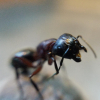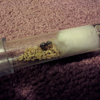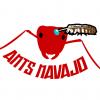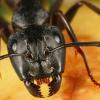- Formiculture.com
- Forums
- Gallery
- Members
- Member Map
- Chat
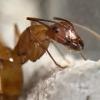
Mold outbreak killed my Camponotus in less than 24 hours
Started By
Aliallaie
, Aug 19 2019 5:49 AM
22 replies to this topic
#1
 Offline
-
Posted August 19 2019 - 5:49 AM
Offline
-
Posted August 19 2019 - 5:49 AM
Hello everyone. I thought I share my past 24 hour experience with my ants. Basically I had my Camponotus chromadose colony living in a 3D ant formacerium from ant shack Formica website. The material inside is wood. They have been living in it for almost 2 months and they were thriving. They went from 12 workers to 30 in a month. Lots of eggs and brood. Also because I was feeding them almost every day they had lots of dead crickets jammed up inside the chambers. The formacerium has no ventilation, therefor there was a bad odor coming from the nest as well. I also have to mention I have a heating cable on one side of the nest. I started seeing black mold in one chamber and maggots. That’s when I decided to clean the nest. I wanted to do it right so I placed the formacerium inside the fridge for about 30 minutes, took it out, lifted the glass cover and quickly cleaned the chambers, took out the dead crickets and everything then I closed the glass lid and placed them back beside their heater. I also have to mention this black mold had started 2 weeks upon them moving inside the formacerium. It seemed that nothing was harming them.
So the nest day I go to check on them I notice 3 dead ants. I wasn’t sure what it was so I went to work came back 8 hours later I see 4 more dead ants. At this point I don’t know what is going on. What is killing them? I decide to place them back inside the test tube. I placed them in the fridge for 15 minutes get them ready and in an hour or so they move inside a test tube. I placed the test tube in a tub and I place some nectar in and right away I see a few workers drinking. The nest day I see 3 more dead, I decided to check them under a lense. I see a white layer all over it. Spots mostly on the gaster and all over their legs and antennas. 2 more died.
As I am posting this right now I have noticed 3 more workers almost dying and I see the layer on them. My concern is if it is mold then why didn’t they die from it before? What has caused this outbreak ? Sudden Change in temperature ? Does mold work like that? I’m at a loss. I’m down to 10 workers
So the nest day I go to check on them I notice 3 dead ants. I wasn’t sure what it was so I went to work came back 8 hours later I see 4 more dead ants. At this point I don’t know what is going on. What is killing them? I decide to place them back inside the test tube. I placed them in the fridge for 15 minutes get them ready and in an hour or so they move inside a test tube. I placed the test tube in a tub and I place some nectar in and right away I see a few workers drinking. The nest day I see 3 more dead, I decided to check them under a lense. I see a white layer all over it. Spots mostly on the gaster and all over their legs and antennas. 2 more died.
As I am posting this right now I have noticed 3 more workers almost dying and I see the layer on them. My concern is if it is mold then why didn’t they die from it before? What has caused this outbreak ? Sudden Change in temperature ? Does mold work like that? I’m at a loss. I’m down to 10 workers
- CamponotusLover and AntLad like this
#2
 Offline
-
Posted August 19 2019 - 6:42 AM
Offline
-
Posted August 19 2019 - 6:42 AM
That's a lot of handling of the ants. I had mold in my nest but as the colony grew they disposed of the rot themselves and removed it. The rest of the decomposition was left and they just stuck it to the ceiling and dug holes through it. Its now part of the nest.
Hope you have better luck next time. What formicarium was it? I'd like to see it. I have the hybrid nest 2.0 arriving today so I'll be able to clean my old formicarium. I'll take a closer look at the mold and rot.
Hope you have better luck next time. What formicarium was it? I'd like to see it. I have the hybrid nest 2.0 arriving today so I'll be able to clean my old formicarium. I'll take a closer look at the mold and rot.
"You don't get what you want. You get what you deserve".
#3
 Offline
-
Posted August 19 2019 - 7:02 AM
Offline
-
Posted August 19 2019 - 7:02 AM
isolate the queen!
#4
 Offline
-
Posted August 19 2019 - 10:15 AM
Offline
-
Posted August 19 2019 - 10:15 AM
That's a lot of handling of the ants. I had mold in my nest but as the colony grew they disposed of the rot themselves and removed it. The rest of the decomposition was left and they just stuck it to the ceiling and dug holes through it. Its now part of the nest.
Hope you have better luck next time. What formicarium was it? I'd like to see it. I have the hybrid nest 2.0 arriving today so I'll be able to clean my old formicarium. I'll take a closer look at the mold and rot.
This is the link to it:
https://www.formica-...e-xlant-habitat
So far today after this post 4 more have died. I do have the hybrid nest 2.0 but I was waiting for them to reach large number then place them in it. I ordered a fortress from THA to place them in it. Seems for now the survivors are all inside the tube in the dark. I noticed any ant that comes out of the tube is coming out to die. They run around in the Outworld and curl up and die.
#5
 Offline
-
Posted August 20 2019 - 4:51 PM
Offline
-
Posted August 20 2019 - 4:51 PM
Yikes! I'm worried about mold outbreaks too and have been wondering how to deal with them inside the nest. I've currently got a small greenish mold outbreak, so I removed the hydration and letting it air out after soaking in a little 3% hydrogen peroxide. My nest's hydration is from the bottom, so I was able to put in a small amount of Hydrogen Peroxide for over 5 mins then letting it air dry now for a couple days to see how that goes.
It sounds like you may have disturbed the mold spores when you cleaned out the nest quickly, which might be covering your ants. The main issue was that the colony kept the food in the nest, either clean out after feeding or house in a smaller nest so they won't bring food in. The humidity of the nest, plus the heat from the heating cable makes the perfect environment for mold outbreaks from organic materials like uneaten food or ant waste. Ants covered in mold spores doesn't sound fun ![]()
- CamponotusLover and TennesseeAnts like this
My Youtube channel: Ants Navajo Keeping- Camponotus pennsylvanicus, Tapinoma sessile x 2, Pheidole sp x 2
"We may be witnesses to a Biblical prophecy come true - 'And there shall be destruction and darkness come upon creation and the beasts shall reign over the earth.'" - Dr. Harold Medford
#6
 Offline
-
Posted August 20 2019 - 5:13 PM
Offline
-
Posted August 20 2019 - 5:13 PM
This is the fastest acting mold I've ever heard of. Could we get pics of the workers?
#7
 Offline
-
Posted August 22 2019 - 7:21 AM
Offline
-
Posted August 22 2019 - 7:21 AM
Hello everyone. Thank you for all your input. So yes I think the same thing happened. When I cleaned them fast the quick temperature drop caused the mold to release spores. The mold lays dormant until something changes in this case the temperature. I also called Mack from Tar Heel ants and he suggested whatever killed them was indeed from the crickets. My mistake was I never froze or boiled the crickets I fed them fresh to the ants. However I moved them into a test tube and with half of them gone they seem fine now. They’re still in shock they haven’t come out of the test tube for days now. But none have died which is great.
- CamponotusLover likes this
#8
 Offline
-
Posted August 22 2019 - 7:59 AM
Offline
-
Posted August 22 2019 - 7:59 AM
The same thing is happening to my Camponotus Modoc. I gave them some brood of a wild colony recently along with some crickets and there was black mold. it was in the garbage chamber so i didn't think to much about it. yesterday i saw 5 ants in the outworld spazing out curled up on there backs, and a couple more running in circles. some of the ants were covered in the mold. but i thought they were just nanitics until now...
I also feed fresh crickets to my ants...
#9
 Offline
-
Posted August 22 2019 - 9:34 AM
Offline
-
Posted August 22 2019 - 9:34 AM
i m sorry for the mold outbreak .
i may buy one of nest from Ant shack .the glasse is ok ? some reflection or glare?
from my part the nest is too big for a small colony . but filling the rooms of sand /vermiculite is a way to "block" the empty room.
the ant will dig when it's time to expand ,and it can force them to use the outworld for the garbage.
#10
 Offline
-
Posted August 22 2019 - 5:30 PM
Offline
-
Posted August 22 2019 - 5:30 PM
Many times people jump to conclusions about mold killing their ants. The ants do a really good job at keeping mold under control, and when they die, many times they are covered in mold the next day, leading people to believe that the mold killed their ants. I'm sure it happens, but probably less often than people think. I think if it does kill the ants, it's probably the CO2 the mold produces.
- CamponotusLover and AnthonyP163 like this
#11
 Offline
-
Posted August 22 2019 - 5:34 PM
Offline
-
Posted August 22 2019 - 5:34 PM
Many times people jump to conclusions about mold killing their ants. The ants do a really good job at keeping mold under control, and when they die, many times they are covered in mold the next day, leading people to believe that the mold killed their ants. I'm sure it happens, but probably less often than people think. I think if it does kill the ants, it's probably the CO2 the mold produces.
what do you think about 15 ants currently spazing out on their backs in the out world? about 3 dead too. ik this probably isn't enough to get a real answer.
#12
 Offline
-
Posted August 23 2019 - 12:54 PM
Offline
-
Posted August 23 2019 - 12:54 PM
That’s exactly the symptoms my ants had when they died. They were running in circles and spazzing falling on their backs. Take them out of the formacerium right away and place them in the test tube. Whatever is killing them will kill them all in the next day. Don’t risk waiting. It’s a black mold yes. Something causes it to trigger, it either releases spores or something. Also I suggest separate the sick ants from the colony.
i m sorry for the mold outbreak .
i may buy one of nest from Ant shack .the glasse is ok ? some reflection or glare?
from my part the nest is too big for a small colony . but filling the rooms of sand /vermiculite is a way to "block" the empty room.
the ant will dig when it's time to expand ,and it can force them to use the outworld for the garbage.
#13
 Offline
-
Posted August 23 2019 - 12:56 PM
Offline
-
Posted August 23 2019 - 12:56 PM
i m sorry for the mold outbreak .
i may buy one of nest from Ant shack .the glasse is ok ? some reflection or glare?
from my part the nest is too big for a small colony . but filling the rooms of sand /vermiculite is a way to "block" the empty room.
the ant will dig when it's time to expand ,and it can force them to use the outworld for the garbage.
Yes the formacerium from ant shack is great and very little glare. I have 2 brand new ones if you like to buy them from me. It takes almost a month for it to be delivered from over seas from their website.
#14
 Offline
-
Posted August 23 2019 - 1:59 PM
Offline
-
Posted August 23 2019 - 1:59 PM
Many times people jump to conclusions about mold killing their ants. The ants do a really good job at keeping mold under control, and when they die, many times they are covered in mold the next day, leading people to believe that the mold killed their ants. I'm sure it happens, but probably less often than people think. I think if it does kill the ants, it's probably the CO2 the mold produces.
Aspergillus flavus, a pathogenic species characterized by a yellow, hairy growth on organic material, such as dead insects in the ant nest, does actually produce a number of potent mycotoxins that may be deadly to ants in the proximity of the mold outbreak.
Here is a small outbreak currently ongoing with one of my colonies. I'm keeping an eye on things to see if the ants can manage it, or if it needs my intervention. For now, I'm just discontinuing watering and limiting feeding so there's not an excess or moisture or uneaten food in the nest, both things that the mold needs to grow further.
Edited by drtrmiller, August 23 2019 - 2:16 PM.
- AnthonyP163 likes this
byFormica® is the manufacturer of the iconic nectar feeders and Sunburst Ant Nectar.
byFormica ant products always deliver consistent performance, convenience,
and reliability, making them among the most beloved ant foods and kit enjoyed by
ant keeping enthusiasts worldwide. For more information, visit www.byFormica.com.
#15
 Offline
-
Posted August 23 2019 - 2:05 PM
Offline
-
Posted August 23 2019 - 2:05 PM
That looks scary.
#16
 Offline
-
Posted August 23 2019 - 4:04 PM
Offline
-
Posted August 23 2019 - 4:04 PM
Many times people jump to conclusions about mold killing their ants. The ants do a really good job at keeping mold under control, and when they die, many times they are covered in mold the next day, leading people to believe that the mold killed their ants. I'm sure it happens, but probably less often than people think. I think if it does kill the ants, it's probably the CO2 the mold produces.
Aspergillus flavus, a pathogenic species characterized by a yellow, hairy growth on organic material, such as dead insects in the ant nest, does actually produce a number of potent mycotoxins that may be deadly to ants in the proximity of the mold outbreak.
Here is a small outbreak currently ongoing with one of my colonies. I'm keeping an eye on things to see if the ants can manage it, or if it needs my intervention. For now, I'm just discontinuing watering and limiting feeding so there's not an excess or moisture or uneaten food in the nest, both things that the mold needs to grow further.
This happens in any setup whenever something organic is left. It is either covered with a blue mold or this yellow mold.
Ant Keeping & Ethology Discord - 2000+ Members and growing
Statesideants.com - order live ants legally in the US
#17
 Offline
-
Posted August 23 2019 - 4:24 PM
Offline
-
Posted August 23 2019 - 4:24 PM
i don't see this in my Camponotus colony as they have removed all the decaying trash out of the nest. However i see black mold on the cork. there's about 20-40 dead and dying in the out world and of a 80 worker colony they are back into the 40's. i seperated the nest from the out world and i hope no more ants get this.
#18
 Offline
-
Posted August 23 2019 - 8:53 PM
Offline
-
Posted August 23 2019 - 8:53 PM
there's almost no hope for my colony. the first symptom i see is them walking in circles with there antenna in the air, then they get this greenish substance on their back. then they flip out and start spazzing. over half of the or more of the ants in the nest are doing the first symptom
#19
 Offline
-
Posted August 23 2019 - 10:10 PM
Offline
-
Posted August 23 2019 - 10:10 PM
Many times people jump to conclusions about mold killing their ants. The ants do a really good job at keeping mold under control, and when they die, many times they are covered in mold the next day, leading people to believe that the mold killed their ants. I'm sure it happens, but probably less often than people think. I think if it does kill the ants, it's probably the CO2 the mold produces.
Aspergillus flavus, a pathogenic species characterized by a yellow, hairy growth on organic material, such as dead insects in the ant nest, does actually produce a number of potent mycotoxins that may be deadly to ants in the proximity of the mold outbreak.
Here is a small outbreak currently ongoing with one of my colonies. I'm keeping an eye on things to see if the ants can manage it, or if it needs my intervention. For now, I'm just discontinuing watering and limiting feeding so there's not an excess or moisture or uneaten food in the nest, both things that the mold needs to grow further.
I hate that mold.
#20
 Offline
-
Posted August 23 2019 - 10:45 PM
Offline
-
Posted August 23 2019 - 10:45 PM
In most cases mold is harmless, especially the black one you often see build up at the cotton in test tubes.
Dangerous is the mold with very fine threads you almost can't see. I lost a colony of Solenopsis fugax to this type of mold. It grew very quickly, basically over night almost all ants were dead:

The black mold while looking a lot more concerning on the right wasn't the problem and had been present for several days, but the one on the left started spreading very quickly. I picked up some of it and it almost looks like a cotton ball:

Since a lot of the stuff dropped out before I took the first picture it might look more harmless than it was...
Of course I don't know what exactly killed the ants (co2 or other gases, or some kind of poison the mold produced) but if I see mold with fine threads again in a test tube or nest I will move the colony out immediately.
Edited by Barristan, August 23 2019 - 10:46 PM.
1 user(s) are reading this topic
0 members, 1 guests, 0 anonymous users




